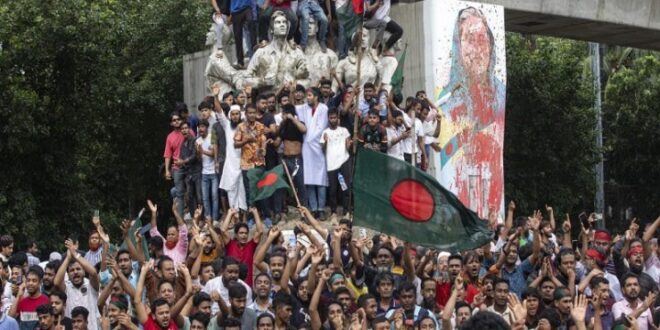Here’s how everything unfolded from the start of this summer’s initially peaceful student-led protests against the judiciary’s reimposition of a contentious government job quota system to the spree of urban terrorism that ultimately forced the country’s long-serving leader to flee for her life to India.
Casual news consumers don’t know much about Bangladesh apart from it being a South Asian country that just experienced a regime change, but it’s also the eighth-most-populous country with one of the world’s largest textile industries and a highly geostrategic position. Bangladesh borders India’s Northeast States that are connected to the “mainland” by the “Chicken’s Neck”, which is only 12-14 miles wide at its narrowest, and some of these same states have been troubled by ethno-separatist unrest for years.
Former long-serving Bangladeshi Prime Minister Sheikh Hasina was a de facto Indian ally despite cultivating close ties with China and the US. She shared Indian Prime Minister Narendra Modi’s vision of regional development and thus allowed his country transit rights across hers for facilitating trade with its Northeast States. Moreover, Hasina prevented her country from being used by related militant groups that are designated by Delhi as terrorists, and she also cracked down on religious radicals too.
Although the Bangladeshi economy rapidly grew under her leadership, she resorted to a heavy hand to maintain domestic stability, which upset the increasingly large number of Islamist-inclined youth who considered her government’s legal cases against the opposition to be “anti-democratic lawfare”. Controversial tactics by the security services inadvertently worsened domestic dissent and ultimately led to targeted sanctions by the US, which was already becoming unhappy with her multipolar balancing act.
The past fourteen months saw the worsening of her ties with America after she accused it of fomenting regime change against her in April 2023, followed by Russia expressing concerned in November that it might orchestrate a Color Revolution during January 2024’s elections that the opposition boycotted. Less than three months ago, Hasina strongly implied that the US was the Western country that she accused of plotting to carve out a Christian proxy state in the region after she rejected its demand for a base.
Shortly thereafter, the High Court reinstated the contentious government job quota system in late June that had been declared illegal in 2018, which served as the trigger event for mobilizing a large segment of the population to take to the streets against that decision. This movement was initially driven by students but was quickly co-opted by opportunistic members of the opposition, Western-cultivated elements of civil society, and religious radicals, which culminated in her resignation and flight this week:
16 April 2023: “Why’s The US Scheming To Carry Out Regime Change In Bangladesh?”
26 November 2023: “Russia Warned That The US Might Orchestrate A Color Revolution In Bangladesh”
10 January 2024: “The Outcome Of The Bangladeshi & Bhutanese Elections Gives India Strategic Breathing Space”
28 January 2024: “The Bangladeshi Opposition’s New Narrative Is Meant To Maximally Appeal To The West”
27 May 2024: “Bangladesh Warned About A Western Plot To Carve Out A Christian Proxy State In The Region
25 July 2024: “The Unrest In Bangladesh Isn’t A Color Revolution But It Could Still Easily Become One”
5 August 2024: “Bangladesh Has Descended Into The Throes Of A Full-Blown Color Revolution”
5 August 2024: “What’s The Best Way Forward For Bangladesh After Its Regime Change Surprisingly Succeeded?”
6 August 2024: “The Post-Coup Political Violence In Bangladesh Bodes Ill For Its Future Direction”
The preceding analyses document the regime change sequence that took place, which continued after the quota system was scaled back and succeeded due to the rioters gambling that the armed forces wouldn’t resort to lethal force to prevent large numbers of them from storming the parliament and her palace. Average Bangladeshis unconnected to the opposition, religious radicals, and foreign forces also participated in them after being enraged at decontextualized footage of state-on-“protester” violence.
This tactic is characteristic of Color Revolutions and was employed by violent rioters, who many suspect to be the opposition Bangladesh Nationalist Party’s (BNP) banned Jamaat-e-Islami allies, provoking the security services into using lethal force as a last resort to restore safety to the streets. Those individuals were joined the unrest after seeing this footage became unwitting “human shields” for deterring the security services from replicating the aforementioned means out of fear of killing peaceful protesters.
Although social media was banned and a curfew imposed, many still came across that footage and an uncontrollable number of angry citizens then spilled into the streets, thus forcing the security services into the dilemma that was just described and leading to them standing down. Hasina fled once it became clear that she couldn’t count on the security services to protect her and uphold the government that she led. Retributive political violence and attacks against the Hindu minority then followed.
India is concerned about the possibility of Bangladesh reverting to the unfriendly country that it used to be under the BNP, which could see it once again host Delhi-designated terrorist groups as part of a major proxy war against this emerging Great Power. Pakistan’s hatred of India is well known, China is embroiled in a bitter border dispute with India, and the US is furious that India won’t submit to being a vassal by dumping Russia and fighting China on its behalf, so all three have reasons to punish it in this way.
Their interests could therefore converge in Bangladesh to pose serious threats to India’s domestic security and territorial integrity. In that worst-case scenario, the combined effect of their policies – whether coordinated or independently promulgated – would be to sabotage India’s rise as a Great Power, thus representing a major power play in the New Cold War. It’s too early to say whether that’ll happen, but it also can’t be ruled out by India either, which is closely monitoring this neighboring crisis.
 Eurasia Press & News
Eurasia Press & News




